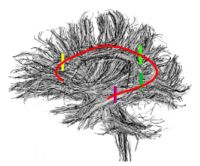DBP2:Harvard
Back to NA-MIC DBP 2
Overview of Harvard DBP 2
Velocardiofacial Syndrome (VCFS) as a Genetic Model for Schizophrenia
VCFS is a genetic disorder characterized by a deletion of a small piece of chromosome-22. The features of this syndrome include deficits in neurological psychomotor and perceptual skills, as well as in cognitive domains such as learning and memory. Most importantly, up to 30% of VCFS patients develop schizophrenia, making it the most commonly known single risk factor for the development of psychosis and a unique model for studying neurodevelopmental changes leading to psychotic deficits. We plan to collect new, high resolution DTI, structural and fMRI data, and apply existing NAMIC tools, as well as help to develop new tools to investigate the contribution of genetic variation to brain and behavioral/cognitive abnormalities, thus bridging the gap between neuroimaging studies and genetics.
The NAMIC community will gain access to de-identified imaging data (new, high resolution structural and diffusion data acquired on the 3T magnet at Brigham and Women’s Hospital). Unlike in schizophrenia, subjects with VCFS have concrete cognitive abnormalities, in addition to a well defined chromosomal abnormality, which, taken together, will make it easier to establish scientific protocols that reveal associated anatomical and functional brain abnormalities in this disorder. Interestingly, some anatomical abnormalities will be shared between VCFS and schizophrenia (e.g., connections within working memory circuits), and some will be not (e.g., sensory and motor paths). Neuropsychological and genetic data will also be collected for each individual as part of separate collaboration between PI and the Children's Hospital("Investigation of Genotype/Phenotype Correlations in Velocardiofacial and DiGeorge Syndromes”) and de-dentified dataset containing neuropsychological tests, clinical evaluations and genetic data will be provided to the PI. The NAMIC project with thus enable the PI to apply NAMIC tools to imaging VCFS data, a genetic disorder that is viewed as a genetically mediated subtype of schizophrenia. To date, there have only been a small number of neuroimaging studies of this disorder and no studies have combined neurocognitive, neuroimaging, and genetic investigations in the same study. Importantly, this research will also increase our understanding of schizophrenia, and will help establish a multimodal research project involving an important collaboration between computer scientists, cognitive neuroscientists, radiologists, psychiatrists, and geneticists. The focus on imaging and genes also affords a new window of opportunity for defining further the new area of “imaging genomics”. More...
Harvard Roadmap Project

|
Stochastic Tractography for VCSFThis project represents a new initiative to build upon a shared vision among Cores 1, 3 and 5 that the field of medical image analysis would be well served by work in the area of validation, calibration and assessment of reliability in DW-MRI image analysis. More... New: Contrasting Tractography Methods Conference, Santa Fe, October 1-2, 2007. |